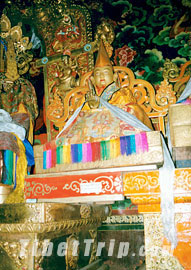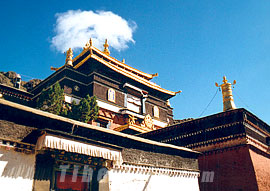
 Dalai Lama
Dalai Lama
The title of 'Dalai Lama' came into being during the third Dalai Lama Sonam Gyatso in year 1578 of the Ming Dynasty (1368-1644). The title Dalai Lama was endowed by the Mongolian leader of Qinghai Province who was converted to Buddhism duo to Sonam Gyatso's missionary work. 'Dalai' means 'Sea' in Mongolian and 'Lama' refers to the word 'Master' in Tibetan. Dalai Lama means 'a master with profound knowledge and transcendent achievements in Buddhist cultivation'. Thus Sonam Gyatso became the third Dalai lama for Gedun Drub and Gedun Gyatso were admited posthumously as the first and second Dalai respectively. The title was acknowleged by the central government of the Ming Dynasty in 1587. Later in the year 1653, Emperor Shunzhi (Qing Dynasty 1644-1911) invited the fifth Dalai to Beijing and conferrd the title 'Dalai lama' on him officially. A gold seal and a gold nominating album were granted together. Since then the title 'Dalai Lama' had been significant both politically and religiously.
 Panchen Erdini
Panchen Erdini
'Panchen' means 'Great Scholar' in Sanskrit and Tibetan. In the year 1645 the leader of Mongolian conferred the title 'Panchen Lama' on Lobsang Chokyi Gyaltsen, who became the forth Panchen Lama with the former three Panchen admitted posthumously. In 1713, the Emperor Kangxi formally granted the fifth Panchen the laudatory title of 'Panchen Erdini', which means 'Treasure' in Manchu. Since then the status of Panchen has been established. For the Dalai and Panchen are followed the reincarnation system, each reincarnated boy should be proved by the central goverment since then.

 Relations between Dalai and Panchen
Relations between Dalai and Panchen
As Dalai Lama and Panchen Lama both root in the Yellow Sect of Tibetan Buddhism, they bear a close relationship with each other. In fact, they bear the relatonship of master and apprentice. For example, the first Dalai was the disciple of the first Panchen. According to the sutras of Tibetan Buddhism, Dalai is the incarnation of Avalokitesvara or the Bodhisattva of Compassion while Panchen the Amitabha, Buddha of Infinite Light. Both of the two play significant role in Tibetans religion and politics. Theoretically speaking, the status of Amitabha is higher than Avalokitesvara, but Dalai Lama was stronger in terms of political and religious affairs. Dalai dominated the front Tibet centered by Lhasa while the rear Tibet centered by Tashihunpo Monastery was ruled by Panchen.
 Succession of Dalai and Panchen
Succession of Dalai and Panchen
Firstly, Dalai Lama and Panchen Lama were succeeded by their disciples. When it came to the succession of third Dalai and fourth Panchen, the Reincarnation System was adopted. According to Buddhism, Buddha's soul never perishes and it incarnates to save mankind. The reincarnated boy should be found and identifed to be the successor. By doing so, the internal strives were avoided. Dalai is said to incarnate to the 14th and Panchen the 11th now.








